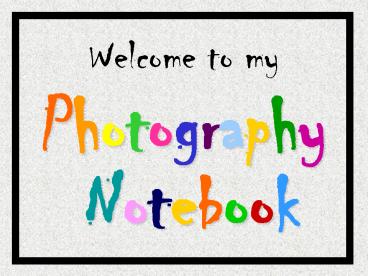Welcome to my - PowerPoint PPT Presentation
1 / 22
Title: Welcome to my
1
Welcome to my
- Photography Notebook
2
Depth of Field
Framing
Candid Shot
Dominant/ Subordinate Elements
Reflections
Simplicity
Leading Lines
Mood/Emotion
Repetition of lines or shapes
Still Life
Shoot _at_ Eye Level
Group Shot
Angles
Portrait
Fill the Frame
Contrast Texture Tone
Shadows or Silhouette
Action Shot
Rule of Thirds
Turn the camera
3
Framing
- Framing is when there is something around the
subject which frames it.
4
Fill the Frame
- Have the subject take up the space in the
photograph. You do not have to get the entire
subject, sometimes partial gives a better
perspective.
5
Shoot Eye Level
- Get at the level of your subject. If your subject
is on the ground, you should be at a low/ground
level also.
6
Leading Lines/Looks
- Leading lines or looks draw the eyes to a
particular place in the photo and gives an
illusion of depth
7
Depth of Field
- Creates an illusion of depth. Sometimes are
blurred in the background or foreground to draw
attention to the subject.
8
Angles
- Choose an angel which is higher, lower, or to one
side of the subject, not straight on.
9
Shadows/Silhouette
- Use of shadows such as below
- or silhouettes like the photo
- to right can add to composition
10
Mood/Emotion
- Capture the emotion or mood of the moment.
Sometimes a photo can tell more than if a person
tries explaining it.
11
Group Shot
- Group shots have 3 or more people in it. When
taking a group shot, focus on the center and make
sure to get close enough to your subjects to see
their faces.
12
Turn the Camera
- Not all photos should be horizontal. If the
subject is vertical, TURN THE CAMERA!
13
Candid Shot
- Catches the subject by surprise or when they are
not looking at the camera. This is opposite of a
posed shot or also called unposed.
14
Reflections
- This is where the subject is reflected either in
a - mirror or off
- the water
- makes for good
- composition.
15
Repetition of lines or shapes
- Draws attention to that particular part of the
photo and looks good visually.
16
Contrast-Texture-Tone
Gives dimension to photo. Contrast is difference
between dark blacks and light whites with the
different shades in between.
17
Action Shot
- Gives an idea of motion, action taking place or
movement and helps the photo to be less boring.
18
Dominant/Subordinate Elements
- Dominant element is the most important where
the focus lies. The subordinate element(s) are
not main center of focus.
19
Simplicity
- Shots which are simplistic in nature can capture
a mood or unique element of the photo.
20
Still Life
- Photos of objects, scenery, etc. They are
inanimate objects. This is not of people or
animals.
21
Portrait
- This portrait shot is taken with purpose. Models
often pose for portraits. They are not just
snap shots.
22
Rule of Thirds
- Divide the frame into 1/3s vertically
horizontally (make a tic-tac-toe grid) place
subject on one of intersections. Do NOT place
subject in center!































